Related Research Articles

The Euphrates is the longest and one of the most historically important rivers of Western Asia. Together with the Tigris, it is one of the two defining rivers of Mesopotamia. Originating in the Armenian Highlands of eastern Turkey, the Euphrates flows through Syria and Iraq to join the Tigris in the Shatt al-Arab, which empties into the Persian Gulf.

The Great Rift Valley is a series of contiguous geographic trenches, approximately 7,000 kilometres (4,300 mi) in total length, that runs from the Beqaa Valley in Lebanon which is in Asia to Mozambique in Southeast Africa. While the name continues in some usages, it is rarely used in geology as it is considered an imprecise merging of separate though related rift and fault systems.
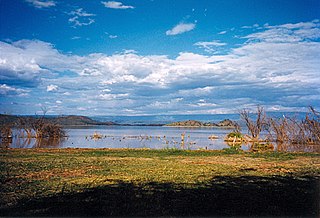
Lake Baringo is, after Lake Turkana, the most northern of the Kenyan Rift Valley lakes, with a surface area of 130 square kilometres (50 sq mi) and an elevation of 970 metres (3,180 ft). The lake is fed by several rivers: the Molo, Perkerra and Ol Arabel. It has no obvious outlet; the waters are assumed to seep through lake sediments into the faulted volcanic bedrock. It is one of the two freshwater lakes in the Rift Valley in Kenya, the other being Lake Naivasha.

Lake Naivasha is a freshwater lake in Kenya, outside the town of Naivasha in Nakuru County, which lies north west of Nairobi. It is part of the Great Rift Valley. The name derives from the local Maasai name Nai'posha, meaning "rough water" because of the sudden storms which can arise.
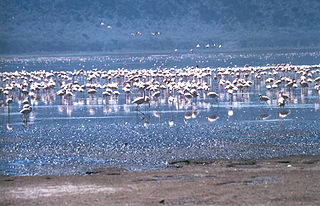
The Rift Valley lakes are a series of lakes in the East African Rift valley that runs through eastern Africa from Ethiopia in the north to Malawi in the south, and includes the African Great Lakes in the south. These include some of the world's oldest lakes, deepest lakes, largest lakes by area, and largest lakes by volume. Many are freshwater ecoregions of great biodiversity, while others are alkaline "soda lakes" supporting highly specialised organisms.

Nakuru County is a county in Kenya. It is County number 32 out of the 47 Kenyan Counties. The capital and largest town is Nakuru, although Naivasha is another major significant urban centre. With a population of 2,162,202, it is the third most populous county in Kenya after Nairobi County and Kiambu County in that order. With an area of 7,496.5 km², it is the 19th largest County in size. Until August 21, 2010, it formed part of Rift Valley Province.

Lake Nakuru is one of the Rift Valley soda lakes at an elevation of 1,754 m (5,755 ft) above sea level. It lies to the south of Nakuru, in the rift valley of Kenya and is protected by Lake Nakuru National Park.

The Aberdare Range is a 160 km long mountain range of upland, north of Kenya's capital Nairobi with an average elevation of 3,500 metres (11,480 ft). It is located in Nyandarua County, west central Kenya, northeast of Naivasha and Gilgil and just south of the Equator. The mountain range is called Nyandarua among the Agikuyu people in whose territory this forest and mountain range is located. The name Nyandarua comes from the Kikuyu word rwandarua meaning a drying hide, due to the distinctive fold of its silhouette.

Naivasha is a large town in Nakuru County, Kenya, lying 92.8 km (57.7 mi) by road north west of Nairobi.
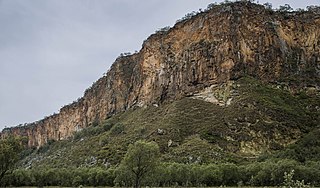
Hell's Gate National Park lies south of Lake Naivasha in Kenya, north west of Nairobi. Hell's Gate National Park is named after a narrow break in the cliffs, once a tributary of a prehistoric lake that fed early humans in the Rift Valley. It was established in 1984. A small national park, it is known for its wide variety of wildlife and for its scenery. This includes the Fischer's Tower and Central Tower columns and Hell's Gate Gorge. The national park is also home to three geothermal power stations at Olkaria. The park is equipped with three basic campsites and includes a Maasai Cultural Center, providing education about the Maasai tribe's culture and traditions.

Gilgil, Kenya, is a town in Nakuru County, Kenya. The town is located between Naivasha and Nakuru and along the Nairobi - Nakuru highway. It is to the west of the Gilgil River, which flows south to feed Lake Naivasha.
Nakuru County Council is a defunct local authority in Kenya. It was one of the largest county councils in the country. It is home to a population of around 1.6 million, living on some 5,000 square kilometres in the central part of the country. The Nakuru area has a rich history, with human settlements dating back more than 3,000 years. The population is very diverse, with residents that have migratory background from different parts of the country. According to 2002 government statistics, on a population total of 1,312,555, the youth population up to age 25 years was 56%. The percentage of pre-primary and primary school going age residents was 31%, and the County’s total labour force population was 54%. The population growth rate is 3.4%.
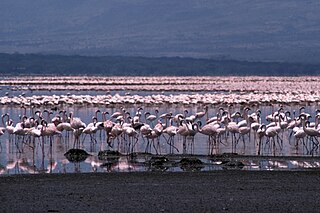
The Great Rift Valley is part of an intra-continental ridge system that runs through Kenya from north to south. It is part of the Gregory Rift, the eastern branch of the East African Rift, which starts in Tanzania to the south and continues northward into Ethiopia. It was formed on the "Kenyan Dome" a geographical upwelling created by the interactions of three major tectonics: the Arabian, Nubian, and Somalian plates. In the past, it was seen as part of a "Great Rift Valley" that ran from Madagascar to Syria. Most of the valley falls within the former Rift Valley Province.
The Malewa River rises in the western slopes of the Aberdare Range in Kenya and flows south and west into Lake Naivasha in the Great Rift Valley. Lake Naivasha is an important source of water in a semi-arid environment, and supports export-oriented horticulture and floriculture businesses as well as tourism. Malewa River water quality has deteriorated because of more human activities in the upper catchment. Long-term effects of this on the percentage of rainfall getting into Lake Naivasha are not clear. Possibly in low-rainfall years the percentage will drop because of water abstraction, while in high-rainfall years the percentage will go up because of cultivated soils having a lower water-holding capacity and the introduction of more 100% runoff surfaces like tarmac roads and iron sheets, etc.
The Gilgil River drains part of the floor of the Great Rift Valley, Kenya and the plateau to the east of the valley, flowing from the north into Lake Naivasha. The river runs to the east of the town of Gilgil, which is on the height of land between the Lake Naivasha and Lake Elmenteita basins.

The Olkaria Area is a region located immediately to the south of Lake Naivasha in the Great Rift Valley of Kenya, Africa. It is geothermally active and is being used to generate clean electric power. The region has an estimated potential of 2,000 MW. This is almost double the maximum daily electricity peak demand recorded in 2008/2009 for the entire country.
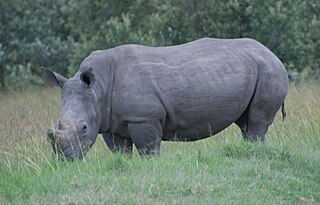
The Kigio Wildlife Conservancy is a protected Conservancy near Gilgil in the Great Rift Valley of Kenya. It is owned and operated by the local community.

The Perkerra River is a river in the Great Rift Valley in Kenya that feeds the freshwater Lake Baringo. It is the only perennial river in the arid and semi-arid lands of the Baringo County. The Perkerra river supplies water to the Perkerra Irrigation Scheme in the Jemps flats near Marigat Township, just south of the lake.

Grahamstown Dam is a major off-stream earthfill Embankment dam with a controlled labyrinth spillway and baffle chute that stores water from the Williams River. The dam is located north of Newcastle and within the Port Stephens Council local government area in the Lower Hunter Region of New South Wales, Australia. The dam's main purpose is water supply; it provides about 40 per cent of the potable water for the Hunter region; and is the Hunter's largest drinking water supply dam.
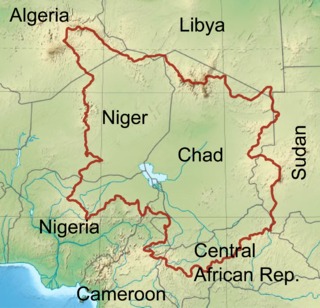
The Chad Basin is the largest endorheic basin in Africa, centered on Lake Chad. It has no outlet to the sea and contains large areas of semi-arid desert and savanna. The drainage basin is roughly coterminous with the sedimentary basin of the same name, but extends further to the northeast and east. The basin spans eight countries, including most of Chad and a large part of Niger. The region has an ethnically diverse population of about 30 million people as of 2011, growing rapidly.
References
- 1 2 3 Harper 2003, p. 16.
- ↑ Thieme 2005, p. 179.
- ↑ Thieme 2005, p. 120.
- ↑ Mbela 1994, p. 641.
- Sources
- Harper, David M. (2003). Lake Naivasha, Kenya. Springer. p. 16. ISBN 1402012365.
- Mbela, D.M. (3 May 1994). "State of Water in Nakuru". Kenya National Assembly Official Record (Hansard). 4 (25).
- Thieme, Michele L. (2005). Freshwater Ecoregions of Africa and Madagascar: A Conservation Assessment. Island Press. ISBN 1559633654.